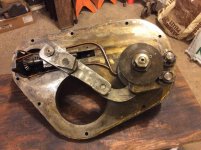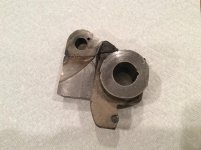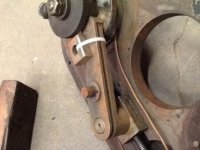Hello Dave:
For fabricating a new part, I would use hot-rolled A-36 steel. It is cheap, readily available, and has good weldability with E 6010 and E 7018. As for the wear characteristics, this is where things get interesting. Cast gray iron has a certain amount of "free graphite" and is an excellent bearing material in its own right.
Making a new part out of steel is a whole other matter in terms of how the part which slides in it will wear. If the part which slides in the broken part is steel, there is a remote chance of galling, but with lubrication, this will not be an issue. My own 'druthers would be to mill the slot oversized, then build it up using silicon bronze or aluminum bronze brazing rod. Once this is done, machine the slot to required finished dimensions.
The reddish sparks you got are consistent with a gray iron part. Probably little or no scrap steel went into the melt. If you do repair it, brazing would be the way to go about it. As I wrote in my previous post, I'd make a fixture to hold the broken parts in alignment. I generally take a piece of structural steel channel and machine pins or studs that fit into the holes in the broken part. With the part put together so the fracture joint mates up, I then weld the pins or studs to the web of the channel. This gives me a fixture that will establish the broken pieces in correct alignment. After that, I vee out the fracture, leaving only a small land at the bottom of the vee. The purpose of this small land is to retain some of the fracture joint. This is my "insurance" that things are properly fitted together- along with the pins or studs or whatever other fixturing I've used. Sometimes, I weld a piece of angle to the channel to make a "fence" that machined flat surfaces can be pushed hard against to line things up. The fixture is my insurance that I've got the broken pieces in good alignment. It sometimes means turning a pin or shouldered stud, but it is worth that extra work up front. Other times, it is as simple as cutting some all thread rod for studs and locking the studs to the broken parts with nuts, then welding the studs to the channel or a piece of scrap steel plate. Making a solid fixture for broken parts that are otherwise next to impossible to clamp together is what I do. I do not own a platen or similar welding table, so making fixtures from scrap steel is about all I can do. Sometimes, it is a combination of tacking together some scraps of angle, channel, plate, and then vise grip welder's clamps to the rescue.
When you go to brazing the casting together, I like to clean the root pass really well. If possible on some jobs, I take a cut on it in the mill or lathe. If not, I run a die grinder and burring tool over the root pass to clean off the bronze and see if I have any porosities or lack of bonding with the base metal. You will know when you are brazing if the base metal is "wetting" or "taking braze", but I like to double check. I also keep an air die grinder with a wire wheel, another with a carbide burring tool, and an air needle scaler at hand when I do these sorts of jobs.
Getting back to type of steel, I prefer to go with a plain carbon structural steel, hot rolled. I try to orient the "rolling lines" in the best directions, much as a woodworker or carpenter will orient the grain of wood in structural applications. A-36 hot rolled structural steel is nothing fancy. It machines reasonably. On some jobs, I actually build up some areas with multiple weld passes to either add generous fillets or create areas that would not be there with the steel used as it was.
Building up pads, fillets, or adding some to get a required diameter in a localized area are all things I've done. I use 3/32" diameter E 7018, DCRP (DC electrode positive) for most of this kind of work. The reason for the smaller diameter electrode is to minimize how much heat I put into smaller parts like your shaper part. I stagger the welds, use a "backstep" technique, and peen the welds as I go along with the air needle scaler. Machining stick welds done with E 7018 and into the base of A-36 steel is easy going, no hard spots or problems, totally homogeneous.
As I said, my only concern would be the wearing that might occur from steel-on-steel with a replacement part made from steel. I keep some silicon bronze and some aluminum bronze brazing rod on hand. I find that using the paste type flux (Stay Silv, I think it is called) or the powdered flux with bare brazing rods gives me a good clean deposit of bronze without too much glassy slag. The prefluxed brazing rods are "low fuming" bronze, which is more of a brass. Chances are it would be OK for your application in terms of wear, and certainly OK to do a brazed repair with.








